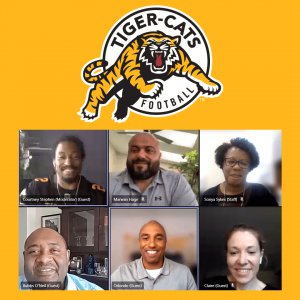
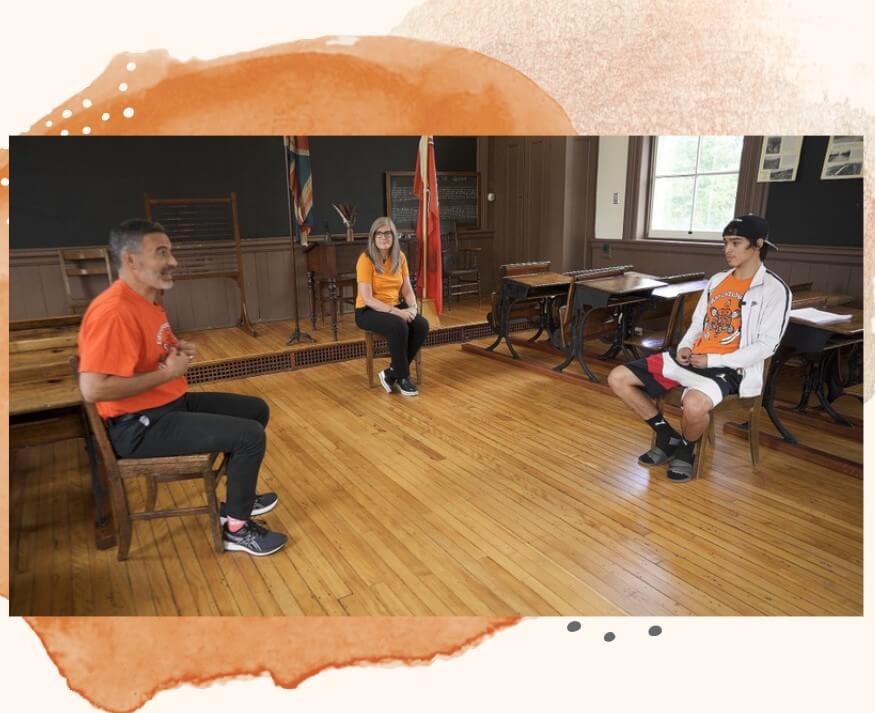 Even amid disruption, in 2020-21 equity, inclusion and our commitment to Indigenous reconciliation remained priorities at Hamilton-Wentworth District School Board (HWDSB). Each year, it is an honour to welcome back students, families and staff, especially when we are able to return in person.
Even amid disruption, in 2020-21 equity, inclusion and our commitment to Indigenous reconciliation remained priorities at Hamilton-Wentworth District School Board (HWDSB). Each year, it is an honour to welcome back students, families and staff, especially when we are able to return in person.
The pandemic presented challenges, but our vision was clear and aligned along five priorities: Positive Culture and Well-being, Student Learning and Achievement, Effective Communication, School Renewal and Partnerships.
We continued to put a special focus on equity, after the 2019 launch of our Equity Action Plan, with the goal of intentionally identifying and addressing inequities and discriminatory practices at the systems, school and classroom levels.
We advanced equity, for example, as Trustees approved a plan with clear timelines to implement recommendations from the 2019 Employment Equity Audit. HWDSB will diversify its workforce at all levels; create a more inclusive and respectful work environment; create more equitable policies and practices; and strengthen the organization’s equity infrastructure.
In this unsettled climate, we remain agile within our existing strategic plan. We are working toward our key performance indicators in the best way possible, which may require a shift in actions, rather than an overhaul of the plan.
After a hiatus last year, we are pleased to share this Director’s Annual Report on how we progressed, made adjustments and prepared for our Board Annual Plan for 2021-22.
Positive Culture and Well-Being
We will build student and staff well-being through positive climate strategies and supportive relationships.
Progress in 2020-21
Goal: All students and staff feel, safe, supported and accepted.
Target #1: The number of students who feel safe, supported and accepted will increase by June 2020.
Strategies:
- Provide differentiated professional learning on Emotion Coaching (i.e. Validation) to school staff, school leaders, and system support staff.
The communication strategy of Emotion Coaching calms the brain and improves relationships through validation and support. After a pause due to the pandemic and provincial job sanctions, we resumed training for all school staff so they could gain skills and practice. Emotion Coaching (Validation + Support) is a key strategy in closing the gap between what students and staff experience as a caring adult interaction. Non-school staff without release time have also requested this training, so we developed a new format with four one-hour sessions over four weeks, as well as an online training format. All staff have access to this training, the training is consistent and sustainable, and we can collect data to measure its effectiveness and application. - Implement Emotion Coaching (ie. Validation), to enhance student-staff relationships (i.e. caring adult).
As with Emotion Coaching, delays in 2019-20 also affected implementation of the Middle Years Development Instrument (MDI) in grades 4 to 8 and the Secondary School Positive Climate Survey in secondary schools. We resumed Emotion Coaching training for school representatives and training at each staff meeting focused on relationships and caring adults. - Identified schools to implement Anti-racism/Anti-oppression (ARAO), Culturally Relevant and Responsive Pedagogy (CRRP) and Indigenous Cultural Safety (ICS) approaches.
We concluded the Ministry CRRP project at Westmount and Bernie Custis secondary schools, where students and staff told us they want to continue learning and discussions about lived experience and creating more inclusive classrooms. System leaders have begun learning on ARAO, centering students’ identities in schools and addressing racism in schools and school leadership practices. Before school resumed in September 2020, staff worked on curriculum designed to support the safe physical, social and emotional re-entry of students to face-to-face learning Learn.Disrupt. Rebuild@HWDSB: Building a Community of Care supported staff as they addressed issues related to equity, mental health, human rights, anti-racism and well-being within the context of the dual pandemics of COVID-19 and Anti-Black Racism. After examining existing structures, requirements, practices, policies and processes, staff have worked with community to create and implement an Indigenous-specific program, the Learning Nest, that immerses Indigenous learners in a classroom that honours, values and accepts Indigenous knowledges, worldviews, teaching and learning pedagogies and ways of knowing, being and doing. This will also involve staff professional learning based on Indigenous Cultural Safety.
Staff was not able to measure the target to have the number of students who feel safe, supported and accepted increase by June, 2020. (Note: Due to the pandemic, the Middle Years Development Instrument (MDI) and Secondary Positive Climate Survey were not administered and this data is the main measure of progress related to feeling safe, supported and accepted. Staff are reviewing data gathered through the Safe Schools Survey (implemented as part of the Bullying Prevention and Intervention Review Panel) and ongoing ThoughtExchange surveys for related measures.
Target #2: The number of staff feeling safe, supported and accepted will increase by June 2020.
Strategies:
- Provide professional learning to service leaders on human rights, systems of oppression and privilege, and implications within the workplace.
Learning sessions on human rights and equity began for Human Resource Services staff, on topics including anti-racism in the workplace, employment equity, bias-free hiring and more. Trustees engaged in human rights and equity learning on a monthly basis in the 2020/21 school year, covering human rights fundamentals, equity-centered education leadership, understanding and addressing racism and anti-Black racism in schools, understanding and confronting Anti-Semitism and Islamophobia in schools, advocating for Two-Spirit and LGBTQIA+ students and Indigenous Cultural Safety. By summer 2019-20, all staff could access the course Human Rights 101 with self-directed online learning planned for 2020-21. - Develop and implement an Employment Equity Action Plan from the Staff Census and Employment Process Review (Audit) recommendations.
HWDSB’s Employment Equity Audit examined Human Resource policies and practices on hiring, advancement, and inclusion of employees from diverse backgrounds. It identified systemic barriers and gaps for HWDSB in four key areas that will guide future work: Diversify the workforce at all levels; Create a more inclusive and respectful work environment; Create more equitable policies and practices; and Strengthen the organization’s equity infrastructure. The 70 recommendations will now support the HWDSB in revising policies and practices, set priorities, and developing resources to continue building a more diverse, inclusive, welcoming and supportive learning and working environment for everyone. In January 2021, school administrators, and service department leaders participated in learning to build capacity on employment equity, unconscious bias and bias-free hiring. - Implement the strategic wellness and absence management plan.
In 2018, HWDSB assessed its absence management programs, practices and procedures to find strengths and areas for improvement, as we strive to reduce employee absences. Staff implemented this plan, with the exception of our staff wellness initiative due to pandemic challenges. We continue to support all staff through our Employee Assistance Program, while addressing barriers preventing staff from attending work regularly.
Staff was not able to measure the target to have the number of staff who feel safe, supported and accepted increase by June, 2020. (Note: Due to the pandemic the Staff Voice Survey was not administered and this data is the main measure of progress related to feeling safe, supported and accepted.)
Action Plan for 2021-22
For the 2021-22 Board Annual Plan, the Positive Culture and Well-Being priority shifted focus to those historically underserved by education systems, specifically naming groups with which HWDSB will employ strategies to improve feelings of safety, support, acceptance and affirmation of individuals diverse and distinct identities. Some of this work was already underway.
Goal: Improve the well-being of all students and staff and close the gap for those currently and historically underserved.
Target #1: At least 80 per cent of students and staff who self-identify as Black, Indigenous, Racialized, Two Spirit and LGBTQIA+, and people requiring special education supports/services self-report feeling safe, supported, accepted and affirmed in their diverse and distinct identities.
Strategies:
- Provide differentiated professional learning on culturally relevant and responsive pedagogy, Indigenous Cultural Safety and Learn. Disrupt. Rebuild @HWDSB with a focus on relationships and conditions impacting current and historically underserved learners.
The expansion of our team is helping integrate the work of equity and well-being into all areas of HWDSB, including mental health and safe schools. The determined Indigenous Cultural Safety team is developing professional learning and development modules, fostering the link between education, health and the ongoing abuses Indigenous communities face. Administrators engage in monthly learning connected to equity, human rights, anti-racism and anti-oppression, while supporting classroom delivery of the Learn.Disrupt.Rebuild lessons in schools. - Provide differentiated professional learning to system leaders on human rights, systems of oppression, privilege, and anti-racism and implications within the learning and working environments.
Leaders and Trustees will continue learning and dialogue on human rights, equity and anti-racism. Staff will develop an online human rights course for all employees. - Implement differentiated strategies to provide targeted and enhanced support to Black, Indigenous, Racialized and Two-Spirit and LGBTQIA+ students and students requiring special education supports and/or services.
As Learn.Disrupt.Rebuild. continues implementation, staff will continue to identify and enhance supports for students from historically marginalized groups, based on barriers identified through the April 2021 student census. We are expanding our Human Rights team to establish and support a human rights policy and complaints procedure. Graduation Coach for Black Students Program at two secondary schools will continue to provide support that is culturally responsive and affirms student identities. The social work supported group Transcend will continue to support transgender students and their families, with facilitators from community partner Speqtrum. We will form new Student Voice networks to inform Board work, from the perspective of racialized students and Two Spirit and LGBTQIA+ students. We will also continue to support Indigenous learners through the student-led organization that spans our system, Cultivating Community: Reclaiming Our Spaces in Education (CC:ROSE). - Implement Emotion Coaching (i.e. Validation), to enhance student-staff relationships (i.e. caring adult).
The focus of Emotion Coaching – a key strategy to support more effective relationships between students and staff – will be on learning the new skills and practicing. Based on feedback, we will emphasize areas of challenge including using Emotion Coaching in adult-to-adult relationships, in virtual interactions, in relationship repair and in validating the student’s emotions. - Implement Employment Equity Action Plan.
The HWDSB Employment Equity Action Plan responds to the 70 recommendations identified by the Equity Audit. The plan will be implemented in 3 phases from January 2021 to June 2022, with four priority areas: Diversify the workforce at all levels; Create a more inclusive and respectful work environment; Create more equitable policies and practices; and Strengthen the organization’s equity infrastructure. - Develop and implement the tools required to collect student identity-based data as part of the Student Census, and updated annually.
HWDSB will be conducting its first Student Census (Student Identity-Based Data Collection) in April, 2021. The purpose of the Census is to gain a deep understanding of who HWDSB students are by collecting voluntary demographic data on racial identity, Indigenous identity, ethnicity, language, gender identity, sexual orientation, language, and so on. The data will support staff in disaggregating student achievement and well-being data by these indicators to be able to track, monitor and address disproportionalities and disparities. Participation in the census is voluntary. Families/students can answer all, some, or none of the questions, depending on their comfort level. A working committee has been created to inform the development and delivery of the Student Census, which includes the gathering of input from Advisory Groups and communication plans to inform the public. Community consultation will be conducted in January and February 2021. Information sessions will then be held to promote and communicate the Student Census among the public between February and March 2021. Staff learning on data literacy and about the Student Census has begun and will continue through the months of February and March. The target date for the administration of the census is April 2021. Data entry, data cleaning and analysis and reporting will be conducted between April 2021 and November 2021. - Develop and implement a Safe Schools Action Plan to respond to the recommendations from the Safe Schools: Bullying Prevention and Intervention Review Panel.
The HWDSB Equity Action Plan and our commitment to human rights, equity, anti-racism and anti-oppression are foundational to our safe schools approaches. Trustees received the report and approved the recommendations from the Safe Schools: Bullying Prevention and Intervention Review Panel on January 25, 2021. Staff are working on a detailed Action Plan which will be shared with Trustees in spring, 2021. This work is not only fundamental to the achievement and well-being of our students, but to our learning environments and structures, including the progressive discipline process and how suspension and expulsion processes are facilitated. In anticipation of these recommendations, some related work included online resources for administrators on safe schools policies, engaging a Safe Schools Advisory Team to develop learning material for schools, engaging administrators to help identify needs, and classroom-level supports for Bullying Awareness and Prevention Week.
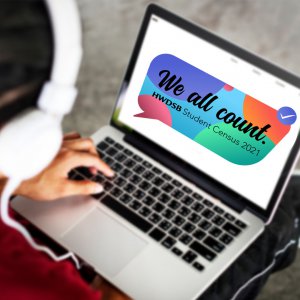 |
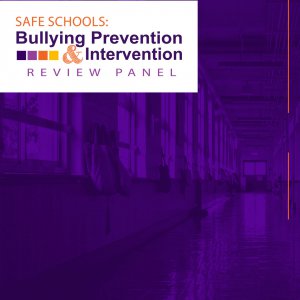 |
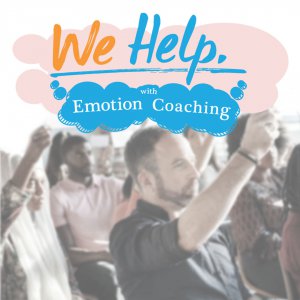 |
| HWDSB Launches First Student Census, We All Count | Trustees Receive Safe Schools Review Panel’s Final Report | What is Emotion Coaching? |
Student Learning and Achievement
We will improve student learning and achievement through effective instructional strategies.
Progress in 2020-21
Goal #1 (Grades 7 to 12+): Improving the graduation outcome for all students and closing the gap for those currently and historically underserved.
Target: At least 80% of students within each cohort making progress towards graduation/graduating.
Strategies:
- Provide differentiated professional learning on culturally responsive and relevant pedagogy, blended learning and personalized learning with a particular focus on engaging learners that are historically underserved.
We looked closely at how the pandemic impacted whether students were on track to get their credits. In October 2020, 22 per cent of courses had students progressing with difficulty, 6 per cent higher than 2019-20. By the November mid-term report, the failure rate in courses was 16% – which was concerning, but still provided staff with months to provide support. Cancelling exams and creating student support days was one way to improve outcomes. Our focus in the second half of 2020-21 was on the de-streaming of Grade 9 math. Learning Services designed and delivered professional development related to embedding culturally relevant and responsive pedagogy (CRRP), Indigenous Cultural Safety (ICS), and Universal Design for Learning (UDL) to teams of grade 7 to 9 educators and administrators. This learning aimed to support students who are currently or historically underserved. After the Ministry of Education released the final destreamed Grade 9 math course, a summer writing team developed a HUB course for MTH1W teachers, called Learning Math Together: Grade 9, with a suggested sequence of activities, assessment tools and practices for the classroom, and learning related to equity. In 2020-21, we prioritized support for all grades 7-12+ educators to use standard digital tools (The HUB and MS Teams) for teaching, especially when a shift to remote learning for all students was required in January and April. Overall, staff enhanced and refined their digital skills and capabilities with these platforms. - Implement instructional, assessment and engagement practices focused on improving the outcomes for all students in Grades 7 to 12.
The pandemic required our staff to learn and implement effective practices in digital learning spaces; this was a new opportunity for many HWDSB educators. Routines and connections mattered. Requiring students to log in regularly, and to use familiar board platforms, reinforced routines such as finding assignments, communicating with their teacher, and submitting work. We shared best practices to foster consistency across classrooms. By shirting from exam days to Student Success Days, students completed outstanding work and earned more credits than might have been predicted at mid-term. We also implemented new practices for transitions from grades 8 to 9. To honour student and parent discussion and choice, a Grade 8 teacher’s approval and signature was no longer required for Grade 9 course selections. We also implemented a new set of guidelines for transitions meetings between elementary staff and secondary staff to ensure discussions before students enter secondary school focus on a student’s strengths, interests, and aspirations. In 2021-22, staff will refine and extend the practices begun in 2020-21. Student Success Days will continue, and schools will have the option of offering exams in Grade 12 college, university, or mixed courses to provide the experience of an exam. - Develop and implement the tools required to monitor the progress students make towards graduation on a regular basis, from Grade 7 onwards at the classroom, school and system levels.
As we refined our measures of progress, we anticipated that in 2021-22 we would use the following measures to see if a secondary student was on track to graduate: credit accumulation; Community Involvement Hours; and completion of the Literacy Graduate Requirement through the Ontario Secondary School Literacy Test (OSSLT) or course (OSSLC). For example, students in grades 9 to 11 who have earned all of their credits and completed at least 10 Community Involvement Hours, are considered on track because they are in a position to graduate at the end of their Grade 12 year. Learning Services is developing an approach to monitoring whether students in grades 7 and 8 are on track to graduate. Measures being considered include report card grades, especially in Language and Math, learning skills, and Grade 6 EQAO performance.- In 2020-21, we measured each cohort’s progress towards graduation using credit accumulation data:
- 77 % of the 2020-21 cohort (this year’s Grade 10) are on track to graduate
- 72 % of the 2019-20 cohort (this year’s Grade 11) are on track to graduate
- 76 % of the 2018-19 cohort (this year’s Grade 12) are on track to graduate
- 77 % of the 2017-18 cohort (this year’s Grade 12+) are on track to graduate
- In 2020-21, we measured each cohort’s progress towards graduation using credit accumulation data:
The Ministry of Education will report on graduation rates for 2016-17 cohort in Spring 2022. HWDSB system level data indicates that we are not on track to meet the target of 80% of students graduating by August 2021. However, there are more than 1,300 students of this cohort currently active and working towards graduation.
Goal #2 (Grades K to 6): Improving the reading achievement of all students and closing the gap for those currently and historically underserved.
Target: At least 75% of students within each cohort on track as an effective reader.
Strategies:
- Provide differentiated professional learning on comprehensive literacy instruction, assessment, and interventions with a particular focus on engaging learners that are historically underserved.
The 2020-21 school year began with Reading Specialists working in Grade 2 classrooms to support educators and students after the school closure period from March to June 2020. Reading Specialists provided small group instruction for students as well as job-embedded professional development on the five components of reading (phonological awareness, phonics, fluency, vocabulary, and comprehension) and the elements of an effective comprehensive literacy program. After November, they shifted to their usual work with Kindergarten and Grade 1 educators and students. The Reading Specialist Team supported Remote Educators in providing small group reading instruction via MS Teams and assessing student reading progress remotely. Our system focus for professional learning was effective instruction in phonics. A foundational skill for effective readers, phonics helps students like sounds and letters to decode new words. - Implement effective reading instruction and assessment practices from Kindergarten to Grade 6.
We closely reviewed student progress reports and attendance amid the 2019-20 school closure and fall 2020 school reopening periods. We found that 91% of students at or above provincial standard in reading, as reported by the June 2020 Report Cards, were progressing well or very well in Language (reading). However, 56% of students who did not meet provincial standard were progressing with difficulty. In High Priority Schools, this percentage was 69.5%, highlighting the importance of the dedicated Reading Specialists deployed to each High Priority School.
Anticipating challenges in Grade 2 reading, Reading Specialists started 2020-21 in Grade two classrooms, supporting educators in implementing early reading practice, determining student learning needs, and co-planning interventions and supports for students who did not earn a B in reading in June 2020. In addition, Learning Services provisioned digital texts and assessment tools to remote and in-person teachers, and deployed the Home Reading with a Heart program to address challenges Grade 1 students faced. We saw progress: more than 75% of Grade 2 students met the provincial standard on the June 2021 report card when only 67% of the cohort met the standard in June 2020. - Develop and implement the tools required to regularly monitor the progress students make towards becoming proficient readers from Kindergarten to Grade 6 at the classroom, school and system levels.
Last year, staff began work on new monitoring tools for reading. The classroom-based Milestones to Reading K-1 was supplemented with a Grades 2 and 3 version that took the same approach to documenting observable reading behaviours to determine if a student was on-track to achieve the provincial standard, rather than only depending on an assessment tool such as the Development Reading Assessment (DRA). As well, staff has developed a phonics assessment tool to support educators in assessing students’ phonics skills and then providing phonics instruction. The Kindergarten – Grade 1 Reading Tracker continued to be used to monitor students at the class and school level. The French Immersion and English as a Second Language Milestones continue to be used in classrooms. In 2021-22, new tools will be reviewed, refined and piloted. Staff is intentionally moving slowly as all existing and new tools need to be reviewed with an anti-racist, anti-oppression and anti-colonial foundation. For example, we have developed a new Kindergarten to Grade 1 Reading Tracker that looks at a wider set of assessment data. A Kindergarten to Grade 6 Reading Tracker may be developed over the course of the school year.
In 2020-21, at least 75% of HWDSB students in Grades 2-6 were on track to be an effective reader.
Action Plan for 2021-22
Goal #1 (grades 7-12+): Improving the graduation outcome for all students and closing the gap for those currently and historically underserved.
Target: At least 80 per cent of students within each cohort making progress towards graduation/graduating.
Strategies:
- Provide differentiated professional learning on culturally responsive and relevant pedagogy, blended learning and personalized learning with a particular focus on engaging current and historically underserved learners.
We will focus on how to support educators in integrating Culturally Responsive and Relevant Pedagogy (CRRP)/Indigenous Cultural Safety (ICS), blended learning, and personalized learning into their daily teaching practices. We do this to deepen staff knowledge and skill in understanding the curriculum, assessment practices, and instructional practices. For administrators and educators in student services and student success, learning on program pathways will continue to help students make pathways decisions based on their interests and aspirations. Staff learning will include support for de-streaming of Grade 9 applied and academic math classes. In Specialized Services, staff have created professional learning courses on supporting students with specific needs, program planning and using technology, with plans to add learning on Individual Education Plans. Learning occurs online, including on websites for Learning4Success , Speech and Language and the Centre for Success. - Implement instructional, assessment and engagement practices focused on improving the outcomes for all students in grades 7 to 12.
Culturally Responsive and Relevant Pedagogy (CRRP), Indigenous Cultural Safety (ICS), Blended Learning, and Personalized Learning foster long-term student success in a modern learning environment and foster 21st century skills students need after graduation. For example, when an educator practices a culturally relevant and responsive approach, “Learning experiences are designed to be relevant and authentic, enabling students to see themselves in the daily learning of the classroom.” Blended learning can foster key digital skills in students, for example, as they collaborate and communicate with peers to complete learning tasks, and when educators ‘flip the classroom’ by posting learning materials and activities prior to a face-to-face lesson. Personalized learning that reflects a student’s strengths, interests and areas of growth may include inquiry learning, the play-based model in kindergarten, experiential learning, and eLearning as students choose courses not available at their home school. De-streaming, as underway for Grade 9 math, is an important equity measure that also reflects students’ interests and aspirations, so that students are not ‘streamed’ due to potential bias or perceptions of their ability. - Develop and implement the tools required to monitor the progress students make towards graduation on a regular basis, from Grade 7 onwards at the classroom, school and system levels.
In spring 2021, we will start new processes to measure the progress of students towards graduation, from Grade 7 onwards. We will ensure these measures are inclusive, honour multiple student pathways, and are developed collaboratively with students and families.
Goal #2: Improving the reading achievement of all students and closing the gap for those currently and historically underserved.
Target: At least 75 per cent of students within each cohort on track as an effective reader.
Strategies:
- Provide differentiated professional learning on comprehensive literacy instruction, assessment, and interventions with a particular focus on engaging current and historically underserved learners.
Implementing effective literacy practices based on research and key resources, such as the Guide to Effective Instruction in Reading, 1-3 and the Guides for Effective Literacy Instruction, Grades 4-6, will be the learning focus in 2021-22. As with the Early Reading Strategy, staff will develop classroom resources and assessment tools, as well as provide professional learning. Learning on implementing CRRP/ICS in Reading programming will also be provided. - Implement effective reading instruction and assessment practices from Kindergarten to Grade 6.
From kindergarten to Grade 6, effective reading instruction occurs through a comprehensive literacy program with modelled, shared and guided instruction, as well as independent practice. Students have success when educators have a strong knowledge of a wide range of teaching practices, what constitutes evidence of student learning, and how to respond to student learning needs appropriately. All HWDSB grades 1 to 6 classrooms have a 100-minute literacy block. Classrooms, be they physical or virtual, support the needs of all learners through diverse and multilingual learning materials. Within these spaces, ongoing assessment of student progress, measured by resources such as The Developmental Reading Assessment (DRA), The Phonological Screener and The Milestones, occurs regularly to enable educators to focus instruction on student learning need. Educators structure their literacy block to provide opportunities for modelled, shared and guided instruction, as well as independent practice of reading and writing skills. The focus in kindergarten to Grade 3 is on the development of reading acquisition skills, such as phonological awareness, vocabulary and fluency. The emphasis shifts in later grades to use the reading skills developed to learn by reading as the students encounter increasingly diverse and complex texts. This shift from learning to read to reading to learn requires students to develop their reading comprehension through critical thinking, inferencing, and word study. - Develop and implement the tools required to regularly monitor the progress students make towards becoming proficient readers from Kindergarten to Grade 6 at the classroom, school and system levels.
In spring 2021, we will begin work to develop and implement new monitoring tools and processes to measure the progress of students toward becoming proficient readers. These new tools and processes will build on existing tools such the Phonological Screener and Milestones resources used in kindergarten and Grade 1. Similar to the improving graduation goal, these measures must be inclusive and developed collaboratively.
 |
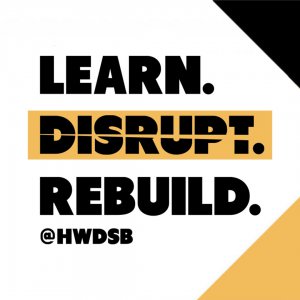 |
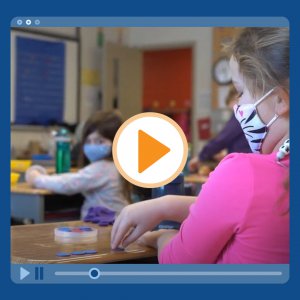 |
| What is a Specialist High Skills Major? | HWDSB Launches Human Rights Education Initiative, Learn.Disrupt.Rebuild | We’re Back in Class |
Effective Communication
We will improve our communication through comprehensive strategies.
Progress in 2020-21
Goal: Improve internal and external communications.
Target: Implement year three of the 2018-2022 Strategic Communications and Engagement Plan
Strategies:
- Complete implementation of the Parent Portal to improve communications with our parents, guardians and caregivers.
A new Parent Portal was launched on August 17, 2020, ahead of schedule, and due to a demand for direct parent communication related to COVID-19. The Parent Portal was launched with the question to parents about whether they wished to send their child to school in-person or in our remote learning program. In addition, staff asked parents whose child/ren were attending in person about the one-time attestation. The new Parent Portal supports families who want to view their child/ren’s grades and attendance, complete school and board forms online, report an absence from school, pay for school items or events using School Cash Online, and find transportation information. More work is being done with direct communication between parent and child’s educator. The Parent Portal is available in English, French, Spanish, Arabic, Urdu, Punjabi, Simplified Chinese, and Serbian. Challenges related to Parent Portal: Prior to the launch of the Parent Portal, Office Administrators in schools had the ability to modify some fields of student, parent/guardian and/or family information (data) in HWDSB’s Student Information System. These modification allowances may been done to accommodate custodial matters, preference in parent email addresses, or family preference in which parent/guardian received school communication. Some fields within PowerSchool have since been clarified and mandated, whereas before there was some local flexibility. The Parent Portal standardized expectations related to the data. - Standardize communications, including digital platforms, to improve communication with staff and students, especially during COVID-19.
Staff initiated a strategy that would standardize digital platforms to improve communication with staff, parents and students. The purpose of this standardization is to improve internal and external communication and support the function with the appropriate tool to use. These platforms are channels of communication, sources of information, and tools for sharing information about HWDSB. Staff continue to narrow the number of channels used and provide clarity in a once crowded network of platforms. The Digital Engagement Advisory Ad Hoc Committee met twice in the 2019-20 school year, to help guide this strategy. On January 28, 2020 Executive Council directed staff to outline a plan that would standardize teaching and learning platforms, including using a standard Board tool for blended learning, phasing out competing platforms, and more. Families validated this strategy in a Thoughtexchange response by 4,009 participants, with 6,425 thoughts, and 134,439 rates assigned. Highly rated ideas included: “Students with multiple teachers would benefit if all of the teachers were using the same applications” and, “A more unified system for all students. I have four kids and the delivery method for each child is different which is difficult. Some are done via the blog, some via email, some Google Drive.” - Enhance digital engagement for external audiences through a storytelling strategy.
A commitment to implement the story-telling strategy was provided by Executive Council on March 10, 2020. Staff have established a structure for creating and sharing positive experiences of students, staff and families within the community. Story-telling will include various forms of communication such as video and written articles to highlight students, partners, schools, programs and staff. All the stories will be done through an equity lens. The framework is based on the audience or program profiled. The stories will be collected and shared on social media and linked to a dedicated web page. They will cover the following areas: Students – because students influence students for success; Partners – because recognition will maintain relationships; Schools – because this is the entry to a family experience; Programs – because this is key to graduation; and Staff – because staff morale is critical to everything we do.
Staff are on target to implement year three of the 2018-2022 Strategic Communications and Engagement Plan.
Action Plan for 2021-22
Goal: Improve internal and external communications.
Target: Complete year four of the 2018-2022 Strategic Communications and Engagement Plan
Strategies:
- Complete implementation of the Parent Portal to improve communications with our parents, guardians and caregivers.
The Parent Portal is a safe, online space where caregivers can feel directly connected to their child’s educational needs at HWDSB. With an enhanced version of the Parent Portal in place for a year, the platform revealed its benefits for caregivers and areas for improvement in the 2021-22 start up. About 20,000 families have accessed the Parent Portal this year, including those with more than one student at HWDSB. Planning has begun for several enhancements, based on feedback: Accessibility and translation, navigation, data integrity and guidance for staff users. In addition, we anticipate the portal will assist registration and school-to-home communication, through the coming announcement feature, School Bulletin. Communication staff will help school staff understand when to use School Bulletin in the Parent Portal, versus the public school website.
- Standardize communications, including digital platforms, to improve communication with staff and students, especially during COVID-19.
After the 2017 NSPRA Audit confirmed that HWDSB had too many technology-based platforms without proper guidance, staff initiated a Digital Engagement Strategy to standardize platforms and communications around 13 endorsed platforms. Clearer channels of communication are being established through initiatives such as the transition from Google to Microsoft, prioritizing MS Teams as a communications platform, and The HUB as a learning operating system. CCE will continue work to help audiences navigate digital tools, using two main strategies: standardized “landing pages” that collect tools for each audience, and standardizing how communication is shared on each platform. - Enhance digital engagement for external audiences through a storytelling strategy.
In January 2021, a plan was in motion to begin telling strategic stories that reinforced positive experiences of students, staff, and families within the community. HWDSB stories profile students, partners, schools, programs and staff. The framework is based on the audience or program profiled. The stories are collected and shared on social media. All the stories are done through an equity lens. This digital storytelling strategy allows human-interest stories to be shared, while maintaining a presence for audiences to consume content related to corporate, Board or ministry news. Storytelling includes various forms of communication such as video and written articles. The content areas feature students, partners, schools, programs, and staff. The storytelling connections to Strategic Directions include positive culture, achievement, well-being, partnerships, learning and school renewal. Staff are currently working with IIT on a new magazine-style layout to display these stories online. When launched, staff will promote this magazine style page and encourage internal audiences to submit story ideas.
The Strategic Communications and Engagement plan extended its three-year plan mandate to four years to mirror the Strategic Directions. Staff are finalizing items as they complete and evaluate the fourth year of the plan. Staff look forward to implementing the final year of this plan and once the Board has confirmed its Strategic Direction goals, work to establish a new Strategic Communications and Engagement Plan will emerge.
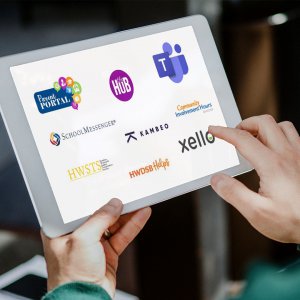 |
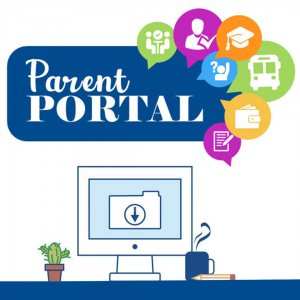 |
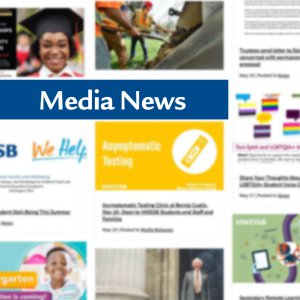 |
| Digital Tools for Families | Parent Portal Supports | Digital Storytelling Strategy |
School Renewal
We will optimize opportunities to invest in improved school facilities.
Progress in 2020-21
Goal: Improve the conditions of our schools.
Target: At least 25 per cent fewer schools will be identified as being in poor condition by 2024.
Strategies:
- Implement the annual capital plan included in the Long-Term Facilities Master Plan, which includes elementary and secondary facility benchmarks, school renewal, repairs and maintenance.
In Year Five of the Capital Plan, the Board was awaiting certain approvals to be able to continue to move forward with the secondary and elementary benchmark work. The Board continued to finalize the secondary fields as part of the secondary benchmark work. Sherwood has also been included as a capital priority submission for May 21, 2021 and the $9 million set aside for benchmark work will be part of the submission. The elementary benchmark work was awaiting the ability to go through Pupil Accommodation Reviews to finalize the Board’s elementary school inventory. In addition, the gym expansions that were not approved by the Ministry are being included as capital priority submission. - Work with municipal partners and the Ministry of Education to ensure that the Board can proceed with the capital projects for which funding has already been received.
As mentioned above, Board staff continue to work with City staff to ensure that approvals are being received in a timely manner. In 2020-21, the Board received some long-awaited Approvals to Proceed from the Ministry. Board staff and Trustees continue to work with Ministry staff and politicians to move these approvals forward. - Maximize funding received through Ministry of Education capital funding opportunities.
HWDSB will submit business cases for 10 capital projects by the May 21, 2021 deadline. The Board will expect to receive the results in the 2021-22 school year. Based on the strength of the business cases, staff is hopeful that HWDSB will continue to achieve success in receiving funding for new school construction.
As we met our previous target, to have 25 per cent fewer schools in poor condition by 2020, the Board has set a renewed target. The new target will see the number of schools in poor condition reduced by a further 25 per cent by 2024. Board staff has also reviewed the classification of a school in poor condition to include more than the FCI, As presented to the Finance and Facilities Committee on April 22, 2021, the assessment will also include equity and accessibility, alignment to facility benchmarks and public consultation. In order to monitor the progress of this target, Board staff provide quarterly monitoring reports to the Finance and Facilities Committee with regards to ongoing capital projects.
Staff are on target to have at least 25 per cent fewer schools in poor condition by 2024.
Action Plan for 2021-22
Goal: Improve the conditions of our schools.
Target: At least 25 per cent fewer schools will be identified as being in poor condition by 2024.
Strategies:
-
- Implement the annual capital plan included in the Long Term Facilities Master Plan which includes elementary and secondary facility benchmarks, school renewal and repairs and maintenance.
- Work with municipal partners and the Ministry of Education to ensure that the Board can proceed with the capital projects for which funding has already been received.
- Maximize funding received from Ministry capital funding opportunities.
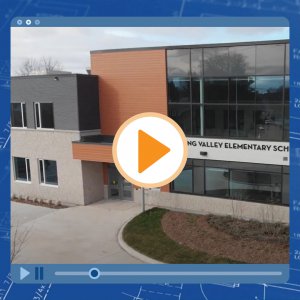 |
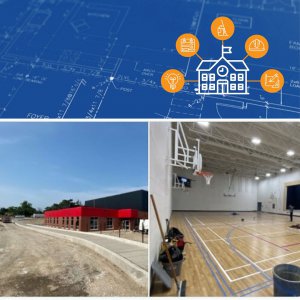 |
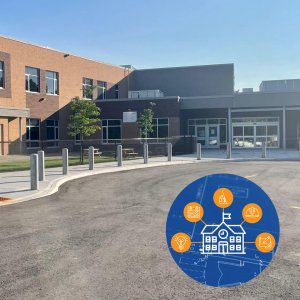 |
| Spring Valley Showcase (video) | Facility Friday – profiles in school renewal | HWDSB develops new way to track facility condition |
Partnerships
We will strengthen our collaboration with new and existing community partners to enhance opportunities for students.
Progress in 2020-21
Goal: All new and existing community partnerships will enhance opportunities for students.
Target: The number of virtual partnership opportunities to support students will increase by 75 per cent.
Strategies:
-
-
- Collect and analyze partnership data for the system and High Priority Schools.
The Community Engagement Department continues to evaluate ways to strategically align schools with unique, educational opportunities. These opportunities are often provided by community organizations and partnerships. The Needs Assessment and Partnership Evaluation Strategy was created to better understand school-based needs and the partners operating within schools, on a yearly basis. Understanding the needs and alignment of programming is crucial in providing targeted, strategic support to students. Focusing the contributions of community partners to align with school priorities maximizes the impact of both the school work and community partner work, reinforcing a Collective Impact Model. This strategy will assist in prioritizing partnerships that are needed for each school year. Beginning in the 2021-2022 school year, this strategy will be embedded within the Continuous Learning and Improvement Process: Learning Roadmap document, and will include two key components: Needs Assessment (Provides an opportunity to better understand the needs that schools have, which allows for more targeted supports to be provided) and the Partnership Evaluation (Provides valuable data pertaining to organizations working with schools, and how impactful those relationships are relative to school needs). - Align community partners’ goals with student needs in High Priority Schools.
Despite safety protocols and limits on in-person placements, HWDSB enhanced its summer 2020 Focus on Youth program in ways that will outlast the pandemic. FOY provides quality summer opportunities for children and youth in Hamilton’s high need areas through employment, leadership training, free and organized programming, and collaboration with other partners. Changes were made to the FOY structure with an expanded week of virtual training with guest speakers; providing tablets to student employees to ensure they could take part in training and virtual placements; new placement streams with community agencies, summer learning camps and senior connectedness programs, which helped students give back to their neighbours. Staff carefully considered the impact of COVID-19 when selecting successful applicants for summer employment, knowing that the pandemic has changed the demographics of student need and those deemed “in/at risk.” - Support partners in providing virtual opportunities for our students to address inequities (income disparity, mental health, racism).
In 2020-21, the Community Engagement Department distributed 43 memos offering virtual programming opportunities to schools. These unique experiences were provided by community organizations and partners in collaboration with HWDSB.
- Collect and analyze partnership data for the system and High Priority Schools.
-
Action Plan for 2021-22
Goal: All new and existing community partnerships will enhance opportunities for students.
Target: The number of virtual partnership opportunities to support students will increase by 75 per cent.
Strategies:
-
-
- Collect and analyze partnership data for the system and High Priority Schools.
- Align community partners’ goals with student needs in High Priority Schools.
- Support partners in providing virtual opportunities for our students to address inequities highlighted by the COVID-19 pandemic (E.g. income disparity, mental health, and racism).
- Collect and analyze partnership data for the system and High Priority Schools.
-
Updated on Thursday, March 31, 2022.



